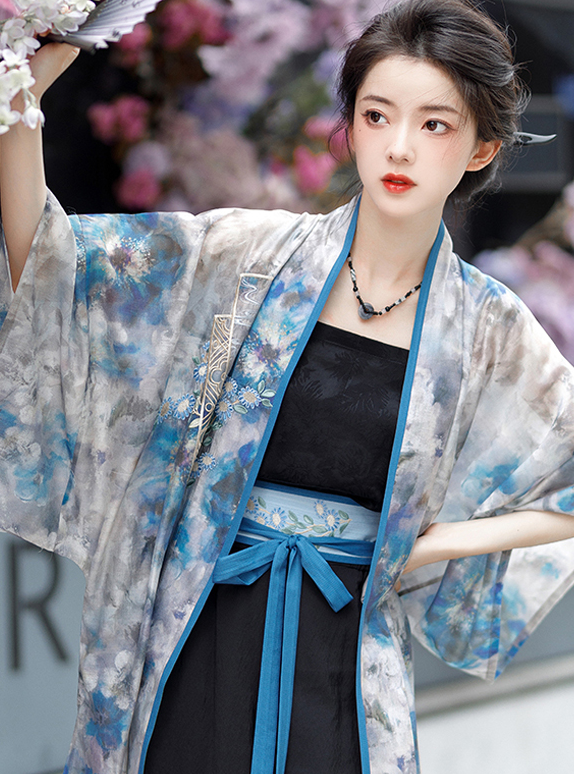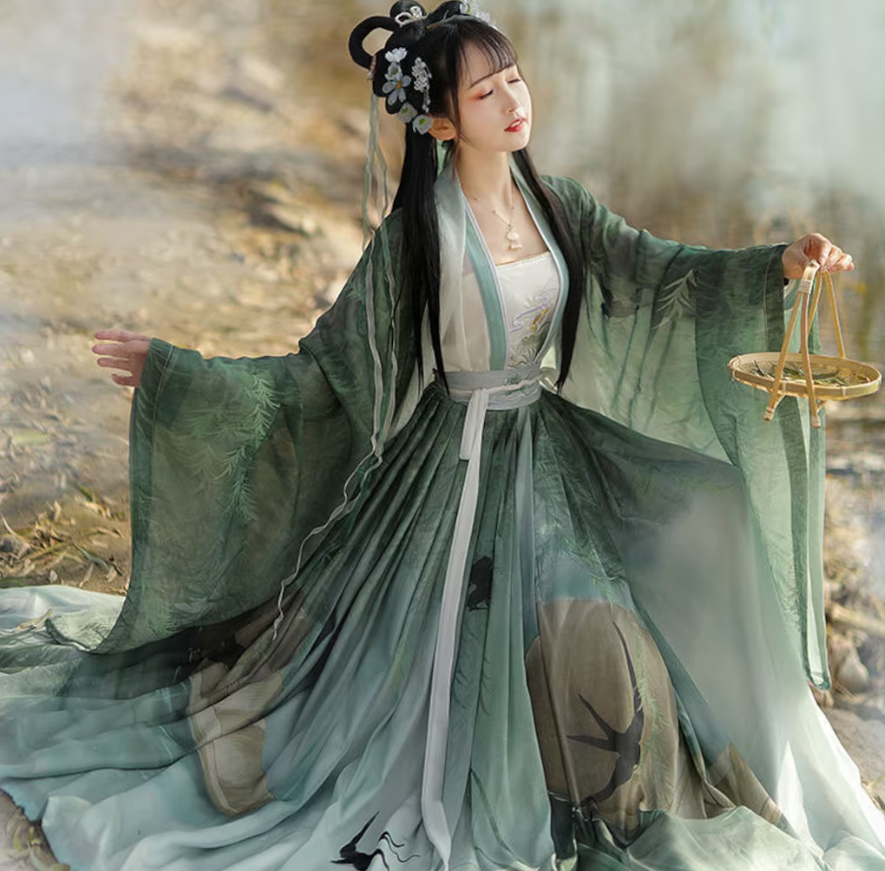Chinese largely stopped wearing Hanfu during the Qing Dynasty, due to Manchu-imposed dress codes and social changes.
Historical Background
The Origins of Hanfu During Ancient China
The term Hanfu literally means “Han clothing,” and it’s the traditional attire of the Han Chinese people. It originated during the pre-Qin period and was later formalized during the Qin Dynasty. Hanfu is characterized by its simple and elegant lines, as well as its deep cultural symbolism. The clothing often consists of robes, gowns, and other garments that wrap around the body, complemented by various accessories like belts and headpieces.
Different regions, seasons, and occasions often called for different types of Hanfu.

The Han Dynasty: Golden Age of Hanfu
The Han Dynasty is often considered the golden age of Hanfu. During this period, Hanfu became a symbol of Han Chinese identity and culture. It was during the Han Dynasty that Hanfu began to diversify into different styles, including the Shenyi, the Ru, and various forms of skirts and tops. The Han Dynasty also saw the rise of elaborate embroidery and ornamental details on Hanfu, which signified rank and class.
This period marked an era of cultural blossoming where Hanfu was not just an item of clothing but a symbol of ethical values and social norms. Confucian ideologies deeply influenced the aesthetics and styles, emphasizing modesty and propriety.
Hanfu in Various Dynasties
The story of Hanfu doesn’t end with the Han Dynasty; it evolved through various dynasties, adapting to the times while retaining its core elements. During the Tang Dynasty, for instance, Hanfu became more open to foreign influences due to the cosmopolitan nature of the society. The styles became more varied, incorporating influences from as far as Persia and Central Asia.
Foreign Influences and the Decline of Hanfu
The Mongol Yuan Dynasty
The Yuan Dynasty, founded by the Mongol leader Kublai Khan, marked a significant change in Chinese culture and fashion. The Mongols, being an ethnic group distinct from the Han Chinese, brought their own styles of clothing and adornments. Hanfu took a backseat as Mongol attire started gaining prominence in official and social settings. The Yuan rulers made efforts to distinguish Mongol culture from that of the conquered Han Chinese, resulting in a decline in the status and visibility of Hanfu. However, among common Han Chinese people, Hanfu remained a form of silent resistance and cultural identity, albeit less publicly showcased.
The Manchu Qing Dynasty
The decline of Hanfu became even more pronounced during the Qing Dynasty. The Manchus, who ruled China during this period, imposed their own style of clothing known as the “Qipao” or “Banner Dress” on the Han Chinese. Strict laws, known as the Queue Order, required Han Chinese men to shave the front of their heads and braid the rest of their hair into a queue, a Manchu hairstyle. This was a clear effort to assimilate the Han Chinese into Manchu culture, further suppressing Hanfu and the Han Chinese identity. Although some Han Chinese continued to wear Hanfu in secret or in private ceremonies, it was largely absent from public life.
Western Influence in the Late Qing and Early Republic
As the Qing Dynasty neared its end, Western influence began seeping into China through trade, warfare, and diplomacy. Western-style suits and military uniforms became popular among the elite and the emerging middle class. With the fall of the Qing Dynasty and the establishment of the Republic of China, the cheongsam and Western-style suits replaced Hanfu as the mainstream clothing options.
Social and Cultural Factors
Confucianism and Hanfu
The role of Confucianism in Chinese culture is undeniable, and its impact extends to the realm of clothing as well. Confucian ideals emphasize modesty, ritual, and social hierarchy, principles that deeply influenced Hanfu designs and the etiquette of wearing them. For example, specific styles and colors of Hanfu signified one’s social status and occupation. Confucian ceremonies often involved wearing particular types of Hanfu, reinforcing the garment’s role as not merely a piece of clothing but also an embodiment of cultural values and norms.
However, as Confucianism lost its hold in the wake of foreign invasions and modernization, Hanfu also lost its symbolic status. Instead, newer forms of attire that aligned with other cultural and ideological systems gained prominence, leading to the decline of Hanfu as a cultural symbol.
Modernization and Industrialization
The waves of modernization and industrialization that swept through China, especially from the late 19th to the early 20th century, changed societal values and lifestyle drastically. Modernization brought along Western notions of practicality and efficiency, which clashed with the traditional and ceremonial nature of Hanfu. New types of clothing, often Western-inspired, became more common due to their practicality and ease of mass production. Tailors and factories started producing Western suits and dresses, which were easier to make and considered more modern, pushing Hanfu further into obsolescence.
The Cultural Revolution and its Impact
The Cultural Revolution (1966-1976) aimed to remove capitalist and traditional elements from Chinese society. Hanfu, with its rich history and traditional values, found itself at odds with the anti-traditional sentiment of the era.
Hanfu in Modern Times
The Hanfu Revival Movement
In the early 21st century, a growing number of young people in China began showing interest in their cultural heritage, sparking what is now known as the Hanfu Revival Movement. This movement aims to bring Hanfu back into daily life, not just as a fashion statement but also as an expression of cultural pride and identity. Social media platforms have become a powerful tool for enthusiasts to share their passion for Hanfu, showcasing its beauty and diversity to a wider audience. Clubs and communities dedicated to Hanfu have also sprung up, providing both virtual and physical spaces for people to explore and celebrate their heritage.
Hanfu in Popular Media
The impact of the Hanfu Revival Movement extends to popular media as well. Films, television shows, and even web series set in historical periods often feature characters dressed in meticulously recreated Hanfu. These productions have captivated audiences and have also served as an educational medium, teaching younger generations about the intricacies of Hanfu and its significance in Chinese culture. The visibility of Hanfu in media contributes to its modern resurgence, normalizing its presence in the public eye and generating interest in its history and aesthetics.

Hanfu in Modern Fashion
The world of fashion has not remained untouched by the Hanfu revival. Designers are integrating elements of traditional Hanfu into modern clothing, blending the old with the new in a manner that resonates with today’s fashion-conscious youth. Even international designers have taken notice, incorporating Hanfu-inspired elements into their collections. Hanfu is making its way into fashion shows and magazines, no longer relegated to historical films or private cultural events.